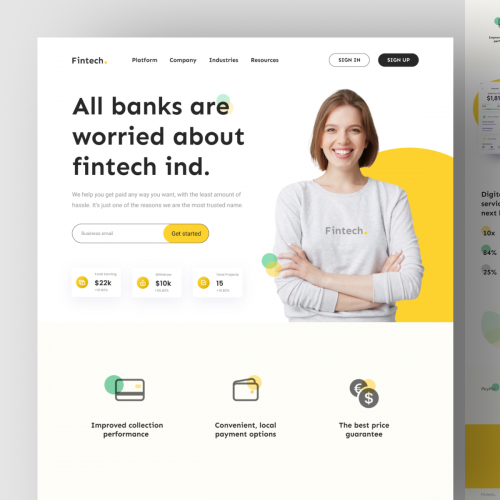Leading Tips for Developing an Impactful Internet Site Layout That Transforms
In today's digital landscape, the value of an impactful web site layout can not be overemphasized, especially when it comes to transforming visitors right into clients. To accomplish this, one have to take into consideration a range of elements, consisting of understanding the target audience, focusing on customer experience, and enhancing for mobile platforms. The calculated usage of compelling call-to-actions and a well-defined visual hierarchy plays a crucial function in assisting customers with their trip. As we discover these crucial components, it ends up being evident that the success of your web site rests on more than just looks; it calls for a thoughtful method to style and functionality.

Understand Your Target Market
Understanding your target market is fundamental to effective site style, as it lays the foundation for creating an interesting individual experience. Identifying who your customers are, including their demographics, preferences, and behaviors, makes it possible for designers to tailor the internet site's content, design, and capability to satisfy particular requirements.
Conducting thorough marketing research is essential in this procedure. Studies, meetings, and analytics can supply useful insights right into user expectations and pain points. By assembling this information, developers can develop individual personalities that represent various sectors of the target market, guaranteeing that style decisions are educated and pertinent.
Furthermore, understanding the target market aids in choosing suitable design elements such as color pattern, typography, and imagery that resonate with individuals. An internet site that speaks straight to its audience promotes a sense of connection and count on, motivating longer brows through and greater conversion prices.
Inevitably, a user-centered strategy to website design not just boosts individual satisfaction yet also supports service goals by driving involvement and loyalty. By prioritizing the needs and preferences of the target audience, a site can efficiently offer its purpose and attain wanted results.
Prioritize Individual Experience
To improve the total efficiency of an internet site, focusing on customer experience (UX) is necessary (Website Design). A well-designed UX makes certain that site visitors can browse the website effortlessly, locate details rapidly, and involve with content meaningfully. This leads to enhanced user contentment and higher conversion prices
Begin by implementing user-friendly navigation. Menus needs to be logically structured, enabling individuals to situate crucial areas of the website with marginal effort. Uniformity in style components, such as color design and typefaces, cultivates experience, which is crucial for keeping customer engagement.
In addition, think about the filling speed of your web site. A delay of simply a couple of seconds can cause considerable drop-offs, as individuals are much less likely to wait on a slow-loading web page. Simplifying images and maximizing code can improve performance and retain visitors.
By prioritizing customer experience, you not just create a much more satisfying atmosphere for visitors yet likewise strengthen your brand name's trustworthiness. Eventually, an emphasis on UX is an investment in the long-term success of your website.
Enhance for Mobile Tools
Enhancing for mobile phones is essential in today's digital landscape, where an enhancing variety of customers gain access to websites via smartphones and tablets. A mobile-friendly layout not only boosts customer experience but additionally plays a substantial role in improving internet search engine rankings. To accomplish this, it is important to embrace a receptive style that immediately gets used to various display sizes and alignments.

Filling speed is another vital aspect; mobile users are generally less client and expect fast access to info. By prioritizing mobile optimization, you make web certain that your internet site remains affordable and properly involves a more comprehensive target market.
Usage Compelling Call-to-Actions
A website's efficiency often depends upon its capability to direct site visitors toward wanted actions, making engaging call-to-actions (CTAs) important parts of design. CTAs function as the essential informative post factors that guide users to engage with the website, whether that implies purchasing, authorizing up for a newsletter, or downloading and install a resource.
To develop effective CTAs, clarity is paramount. Usage succinct language that plainly connects the action you want the customer to take.
In addition, the style of CTAs must stand apart without being meddlesome. Employ contrasting shades and clear typefaces to ensure they catch interest. In addition, consider using directional cues, such as arrowheads or photos, to lead users towards these buttons. By concentrating on these aspects, organizations can significantly enhance customer interaction, driving conversions and inevitably attaining their website's objectives.
Concentrate On Visual Hierarchy
Effective website layout depends heavily on a well-structured visual power structure that overviews customers with content flawlessly. By arranging components in a fashion that prioritizes information, designers can enhance user experience and promote decision-making. This includes utilizing size, shade, contrast, and spacing strategically to accentuate one of the most important components of a website.
The use of bigger typefaces for headings and subheadings establishes a clear difference in between different areas, permitting customers to scan content effortlessly. In addition, using contrasting shades for switches and calls-to-action can capture customer attention and encourage interaction. Whitespace is one more vital element; it avoids mess and allows individuals to focus on key messages without disturbances.
Photos and graphics need to match the text while likewise sticking to the established hierarchy, enhancing the total message (Website Design). Uniformity in layout elements, such as color design and typography, additional strengthens the visual hierarchy, making navigating intuitive
%20%5B60%25%5D.jpg)
Conclusion
Finally, effective website design necessitates a detailed understanding of the target market, prioritization of individual experience, and mobile optimization. The tactical use of compelling call-to-actions and a well-defined aesthetic power structure even more improves individual engagement. By executing these concepts, web sites can attain greater conversion rates, guaranteeing that design components not only bring in visitors yet likewise help with smooth that site navigation and interaction. Eventually, a well-executed site style offers as an essential element in driving customer actions and attaining business objectives.